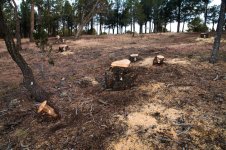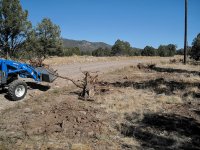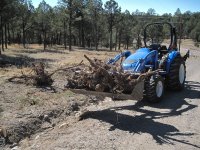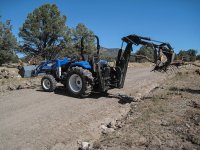Coyote machine
Super Member
- Joined
- May 4, 2009
- Messages
- 7,663
- Location
- Southern VT
- Tractor
- 22 SANY SY 50U, '10 Kioti DK 40se/hst KL-401 FEL, loaded tires, KB-2485 bhoe, Tuffline TB160 BB, Woods QA forks, MIE Hydraulic bhoe thumb & ripper tooth, Igland 4001 winch, & GR-20 Log Grapple. Woods BBX72" Brush Mower. Diamondplate aluminum canopy
Thanks Blue.
You did a real good description of your slaying. Were those stumps fairly old- meaning had the trees been cut some time ago? It looked that they were from the pics. What HP do you get at the hoe with the independent pump? Is it greater than if it were to run off the tractor's hydraulics?
You did a real good description of your slaying. Were those stumps fairly old- meaning had the trees been cut some time ago? It looked that they were from the pics. What HP do you get at the hoe with the independent pump? Is it greater than if it were to run off the tractor's hydraulics?
CM you do a heck of a job creating a visual using verbiage can't say I will do as well, but here goes.
The learning curve was not as bad as I had thought, but I was pretty comfortable with the controls from past use. I did make a few silly beginner errors like forgetting to put the stabilizers down, on the first insertion pivoting on the rear tires and "teeter tottered" me in the seat toward the ground and the front wheels went up. :loser: Another was not having the engine rpm sufficient causing lack of power, my backhoe is driven by its own pump off the PTO. Optimum RPM seemed to be 2200 - 2400 it was very noisy but I used my forester helmet ear muffs to quiet things down... as well as the helmet face shield for the flying dirt.
Initially I found myself positioning to far from the stump, where I had to extend the boom & dipper about half their travel to reach. Although this worked on the very dead and smaller stumps which I started with. It did cause me to lose leverage when I got the inside arc of the ripper under a strong root. Learning from this, I approached things differently on the big stump I knew I would have a difficult time with. Those I planned on attacking from multiple sides, usually only moving once at 90 degrees from the initial position. I found it best to position the boom, dipper & ripper in full closed position and backed up square and just in front of the stump. This was the point at which I felt I could get the maximum leverage from the hydraulics. Although it looked too close initially, after the stabilizer were down it gave me good position and I could see real well what I was doing from my perch. I never found I had to readjust my position farther back and typically completed the stump removal on the my re-position at 90 degrees. I did however after the stump was loose, move tractor further away to clean the debris from the root ball as I was too close to pick the roots clean.
My wife didn't get any good pics of the approach... but these kind of show what is too far away (first one) and the about right position (second one)
View attachment 344265 View attachment 344266
As for the technique used to sever the roots, this was a complete combination of using all controls to get a grip on the root. The control that did the most work was the bucket curl. When I had a good hold under the root, the curl was the driving force that allowed me utilize the teeth in a slight sawing motion and then pop that root in half... it was very impressive. I had many roots that I lost grip on as the ripper violently squirted out from under it. Those I would just try to slightly re-position the boom radially from the stump axis to get a new grip in a weaker area (roots get smaller and easier to break further from the stump axis). This however causes you to get some quite large craters when you finally get the stump out!
You and IslandTractor both warned me about those slippery roots. One of the suggestions that IT had was to add a "reversed raised barb" just after the point and before the first tooth to help catch & hold the root. This would have definitely helped in these instances, but it might also have aided in getting it stuck as well. The wedge shape of the ripper allows it to go down, in & under easily and if stuck doesn't always come out easily. I found myself dealing with a lot more rock than anticipated and I got completely stuck a couple times which left me helpless for a few moments. I got the ripper deeply buried under a root with the back of it against a non-visible large rock. This situation allowed me no travel with any controls, after trying for a few seconds with no luck except the entire tractor shifting on the stabilizers. :scratchchin: I finally figured out the only adjustment I had was the stabilizers. Using these allowed me the wiggle room to get the ripper out. I really thought I was in deep ca-ca!
I did try the approach using the FEL with tractor in low gear to dislodge the stump after severing the roots. Although this worked well IT WAS NO WHERE NEAR AS FUN as completing the entire removal with the ripper! There was complete satisfaction behind the controls of the backhoe when that big *** stump wiggled and twisted out of its spot! I found myself having WAY too much fun doing this. The FEL approach would be your best option if your trees have a main center core or stem root, like a carrot has. The pines I was dealing with have numerous axial roots running away from the tree axis, making the "ripper only" use desirable. Although I did bring my sawzall with me (as recommended by some) I did not use it due to the rocks and as I was insistent on accomplishing this with my new toy! I also really enjoyed clearing out the debris (rock & dirt) from the root ball as it really taught me finesse of the backhoe controls.





